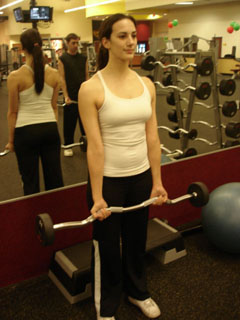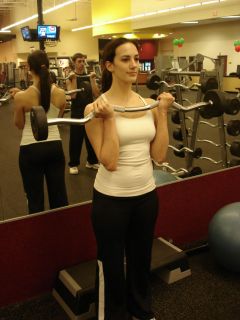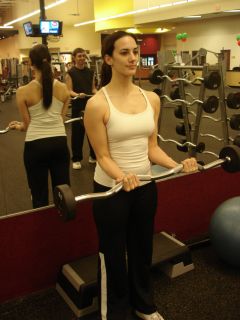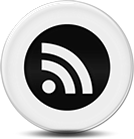Barbell Curls
Barbell curls -- exercise to strengthen the biceps and brachialis muscles
Barbell curls are a primary exercise for the muscles in the front of the upper arm.
The muscle we primarily think of in this area is the biceps. This is the one bodybuilders show off when they flex their arms.
The biceps helps flex the elbow. It is also used to pronate the forearm (in this case pronate means to turn the palm upward.)
Brachialis muscle
Deep to the biceps is another muscle, one that is not so obvious when you view the arm. That muscle is the brachialis muscle.
The brachialis is actually the primary muscle for flexing the arm at the elbow.
Start with arms extended, gripping barbell with both hands

Barbell curls -- starting position
Your palms should be facing away from your body. Your back should be straight.
If you have a tendency to lean backward when doing this exercise you may be using a weight that is too heavy for you.
Contract your muscles and slowly raise the weight.
Raise the bar until your biceps are fully contracted

Barbell curls -- second position
You should be able to feel the tension in the upper arms.
Now slowly lower the weight to the starting position. Don't let the weight drop -- get the benefit of the "eccentric" movement.
Eccentric exercise
Eccentric movements are those in which the muscle is lengthening while it is under tension. Half the results you get from weight training can come from the eccentric movements if you exercise properly.
With barbell curls the eccentric part of the movement is when you are lowering the weight to the starting position. That is why you don't just let the weight drop. You want to always lower the weight in a controlled fashion.
You can do "21s" with barbell curls

Barbell curls -- elbows at 90 degrees
To do 21s with barbell curls you do three sets of exercises, each with 7 repetitions. You do the first set moving the bar from the starting position to the 90 degree position.
The second set you move the bar from 90 degrees to the fully flexed position. Then for the third set you use the full range of motion.
Special points regarding barbell curls
The muscles in the upper arm, particularly the biceps, are not large muscles. You don't need heavy weights to train them.
And you shouldn't overtrain them either. Big biceps look nice -- and all the bodybuilders have huge biceps, right? -- so there is a tendency to overdo it with biceps exercises.
But the big bodybuilders take a lot of drugs to help get their biceps that way. You should set goals for your body development that are realistic.
Avoid injury
Don't try to go too heavy when training biceps. I personally have known three advanced bodybuilders -- in one case a guy who bench presses 500 pounds -- who ruptured their biceps tendon doing curls. And a ruptured biceps tendon means surgery.
Be particularly cautious with this exercise, or any exercise for that matter, if you have recently taken a "fluoroquinolone" antibiotic. The quinolones -- known for example as Cipro and Levaquin in the U.S. are associated with tendon rupture -- without warning and without excessive strain or lifting -- in the weeks after taking the medication.
Popular articles:
With weight loss, knowledge is power...
If you know these few truths on this page -- and if you apply them consistently in your life...
If you can't stay on it forever and be fit and healthy and strong -- then it's an extreme diet.
Here's the easy way to ruin any slightest chance you have of losing weight...
Can you eat in restaurants and still respect yourself in the morning?
Calorie density is the difference between vegetable soup and a bagel.
Hidden calories that ruin your waistline...
Will it really help to drink water to lose weight?


